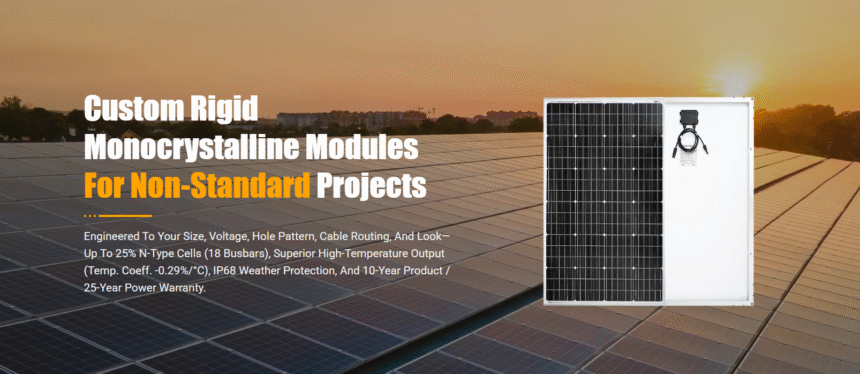Subhead: What to check, how to compare proposals, and why shade resilience may matter more than you think.
Why off-grid is a different game
Going off-grid isn’t just “solar, but without the utility”. Your system must perform through winter, storms, and shade; it has to start pumps and freezers, keep communications online, and do so safely for years. Picking the right company is therefore less about the lowest quote and more about engineering discipline, component quality, and lifetime support.
Below is a step-by-step framework to shortlist vendors, compare proposals like-for-like, and make smart technology choices—especially around shade management, one of the most common real-world performance killers.
Shortlist the right kind of partner
Ask each provider to address these specifics in writing:
Proven off-grid track record. Ask for two recent off-grid references similar to your climate and load profile (e.g., “wooded cabin, 48 V bank, winter temps −10 °C”).
Load + autonomy modelling. Do they model daily Wh, days of autonomy, depth of discharge, PV array derates, and seasonal production? You should see numbers, not guesswork.
Component transparency. Exact module models, batteries (chemistry, warranty cycles), charge controllers (MPPT vs PWM), inverters (surge ratings, waveform), and protection gear.
Standards & certifications. Look for IEC 61215/61730 on modules, relevant fire class, and corrosion standards such as IEC 61701 (salt-mist) or IEC 62716 (ammonia) for farms/marine.
Monitoring & support. Remote monitoring (module/string level if possible), fault alerts, spare-parts policy, and RMA process clarity.
Documentation. Single-line diagrams, torque specs, earthing plan, and maintenance checklist belong in the handover pack.
Red flag: “We’ll size it after installation.” Off-grid success starts with design, not with a van on the driveway.
Why shade resilience should sit on your must-have list
Most off-grid sites have some shade some of the time—chimneys, vents, railings, trees, masts, or seasonal low sun angles. In conventional strings, a small shaded patch can drag down the current of the entire series circuit, creating mismatch losses that wipe out afternoon production.
What to look for
Cell-/substring-level shadow management. Panels engineered with segmented strings and robust bypassing prevent a small shadow from collapsing the whole module’s output.
MPPT granularity. Pair shade-resilient modules with appropriate MPPT channels (multiple trackers or optimisers) to localise and limit losses.
Thermal behaviour. Shade can create hot-spots; better laminates and electrical segmentation help avoid local overheating.
A practical example: Sungold SGM rigid solar panels with anti-shadow engineering
Sungold’s SGM series rigid modules combine the mechanical stability off-grid users want (rigid frame, high wind/snow load ratings) with cell-level shadow management designed to maintain stable power when partial shading happens. In field deployments, such architectures can cut typical shade-induced losses dramatically (e.g., reducing scenarios that might lose ~30–50% on conventional strings to low double digits or even single digits, depending on geometry and controller setup). The point isn’t magic numbers; it’s that the system keeps producing usable power when life throws leaf shadows, guy wires or vent caps across the glass.
Panel choice for off-grid: why rigid often wins on roofs and racks
For cabins, homesteads, telecom sheds, and ranch infrastructure, rigid modules are still the workhorse thanks to:
Mechanical strength. Look for wind load ratings around 2400 Pa and snow loads up to 5400 Pa; rigid frames resist warping on racks and seasonal ice.
Thermal stability. Glass/rigid construction helps with heat dissipation, keeping operating temperatures—and thus losses—lower.
Serviceability. Standard frames simplify mounting, tilt adjustments, and future swaps.
Where roofs are curved or weight-limited (e.g., some RV or marine surfaces), flexible modules may be appropriate, but for fixed off-grid arrays exposed to harsh winters, rigid, shade-tolerant modules like SGM are a robust default.
How to compare proposals apples-to-apples
Ask each bidder to fill the same comparison table:
| Dimension | What “good” looks like | Vendor A | Vendor B |
| Array size | kWp sized from modelled Wh/day + seasonal derates | ||
| Batteries | Chemistry, cycles @ DoD, usable kWh, temp range | ||
| Inverters | Continuous & surge (≥2× motor starts), efficiency | ||
| Charge control | MPPT count & range, shade strategy | ||
| Modules | Rigid, shade-managed (e.g., SGM); IEC 61215/61730 | ||
| Monitoring | Module/string telemetry, remote alerts | ||
| Structure | Wind/snow load calcs, corrosion class | ||
| Warranty | Product & performance, RMA steps | ||
| Documentation | SLD, earthing, torque map, maintenance plan | ||
| TCO | Capex + five-year opex, spares provisioned |
If a proposal is cheaper because it omits MPPT granularity, lighter frames, or any shade strategy, your sticker price may be low while your winter kWh is even lower.
Real-world vignettes (what “good” looks like)
- Wooded cabin, 48 V bank
Challenge: morning/afternoon tree shade.
Solution: SGM rigid array with module-level shadow management, two MPPT channels per roof plane, conservative winter tilt, and a slightly oversized array to maintain charge windows. Result: stable charging even on partly shaded winter days. - Ranch well-pump shed
Challenge: short, heavy surges; dust; bird shadows.
Solution: high-surge inverter, shade-resilient modules, steel racking with anti-corrosion coating, and a cleaning schedule baked into O&M. Result: reliable starts and fewer nuisance low-voltage trips. - Telecom relay
Challenge: must run 24/7; intermittent mast shading.
Solution: stringing layout that isolates shaded modules, multi-MPPT controller, and telemetry for proactive maintenance. Result: high uptime without oversizing batteries to extremes.
The off-grid site visit: what your installer should measure
Solar access & horizon scan (photos or lidar/compass plots), not just “it looks sunny”.
Mounting substrate (timber, steel, concrete) and fixings (corrosion class).
Earthing/bonding path and lightning considerations.
Cable routing with voltage-drop calculations (especially on 12/24 V systems).
Thermal placement for batteries/inverters; don’t cook your electronics.
Service access for cleaning and seasonal tilt changes.
Operations & maintenance plan (O&M)
A credible O&M section includes:
Remote monitoring (module or string trends, alarms)
Preventive checks (torque, connectors, insulation resistance)
Seasonal actions (tilt, vegetation control, snow clearing).
Spares (fuses, MC4 sets, a spare module if remote).
RMA clarity (who ships what, turnaround times).
Where Sungold SGM fits—without the hype
If your off-grid site will ever see partial shade, it’s worth asking vendors to propose a shade-resilient rigid module. Sungold’s SGM series is a representative design: rigid construction for wind/snow resilience and anti-shadow architecture to keep delivering stable power when a portion of the module is shaded. Pair with appropriate MPPTs and good string layout, and you get more usable charge windows—especially valuable in winter and during storms.
(If you’re assessing SGM, request the data sheet: mechanical loads, temperature coefficients, certifications, and bypass/segmentation design.)

Final checklist & next steps
Get three bids using the same load model and the same data sheet transparency.
Insist on a shade plan (module design + MPPT count + string layout).
Choose rigid, shade-resilient modules for fixed off-grid arrays (e.g., Sungold SGM)
Verify mechanical loads, certifications, and fire class.
Lock in monitoring + O&M before paying deposits
Interested in a shade-resilient rigid option? Ask your installer to include a Sungold SGM series line item, or request the SGM data sheet and anti-shadow architecture notes to assess fit for your site.







